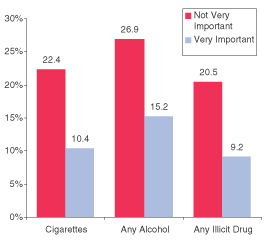
 |
| January 30, 2004 |
|
In Brief |
|
Prior research suggests that religiosity serves as a protective factor for substance use and that higher levels of religiosity are associated with lower levels of substance use among youths.1 The National Survey on Drug Use and Health (NSDUH), formerly the National Household Survey on Drug Abuse (NHSDA), includes questions about cigarette, alcohol, and illicit drug use during the 30 days prior to the survey interview. "Any illicit drug" refers to marijuana or hashish, cocaine (including crack), inhalants, hallucinogens, heroin, or prescription-type drugs used nonmedically. Youths also were asked to indicate how often they attended religious services, whether their religious beliefs are a very important part of their lives, and whether their religious beliefs influence how they make decisions.2,3 Responses were analyzed by gender and race/ethnicity.4
Among youths, females were more likely than males to attend religious services, to report that religious beliefs are a very important part of their lives, and to indicate that religious beliefs influence how they make decisions (Table 1). White youths were more likely to attend religious services 25 times or more in the past year than black or Hispanic youths. However, black youths were more likely to report that religious beliefs are a very important part of their lives, and that religious beliefs influence how they make decisions compared with white and Hispanic youths.
Table 1. Percentages and Standard Errors of Youths Aged 12 to 17 Reporting Religious Factors, by Gender and Race/Ethnicity: 2002 |
Figure 1. Percentages of Youths Aged 12 to 17 Reporting Past Month Substance Use, by Past Year Religious Service Attendance: 2002 |
 |
 |
Figure 2. Percentages of Youths Aged 12 to 17 Reporting Past Month Substance Use, by Whether or Not Religious Beliefs Are a Very Important Part of Their Lives: 2002 |
Figure 3. Percentages of Youths Aged 12 to 17 Reporting Past Month Substance Use, by Whether or Not Religious Beliefs Influence How They Make Decisions: 2002 |
 |
 |
| The National Survey on Drug Use and Health (NSDUH) is an annual survey sponsored by the Substance Abuse and Mental Health Services Administration (SAMHSA). Prior to 2002, this survey was called the National Household Survey on Drug Abuse (NHSDA). The 2002 data are based on information obtained from 68,126 persons aged 12 or older, including 23,645 youths aged 12 to 17. The survey collects data by administering questionnaires to a representative sample of the population through face-to-face interviews at their place of residence.
The NSDUH Report prepared by the Office of Applied Studies (OAS), SAMHSA, and by RTI in Research Triangle Park, North Carolina. Information and data for this issue are based on the following publication and statistics: Office of Applied Studies. (2003). Results from the 2002 National Survey on Drug Use and Health: National findings (DHHS Publication No. SMA 03–3836, NHSDA Series H–22). Rockville, MD: Substance Abuse and Mental Health Services Administration. Also available on-line: http://www.oas.samhsa.gov. Additional tables available upon request. Because of improvements and modifications to the 2002 NSDUH, 2002 estimates should not be compared with estimates from the 2001 or earlier versions of the survey to examine changes over time. |
| The NSDUH Report (formerly The NHSDA Report) is published periodically by the Office of Applied Studies, Substance Abuse and Mental Health Services Administration (SAMHSA). All material appearing in this report is in the public domain and may be reproduced or copied without permission from SAMHSA. Additional copies of this report or other reports from the Office of Applied Studies are available on-line: http://www.oas.samhsa.gov. Citation of the source is appreciated. |
|
 This page was last updated on May 16, 2008. |